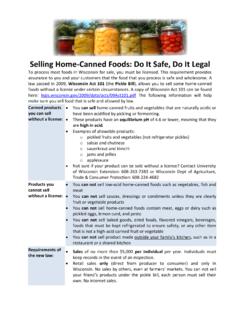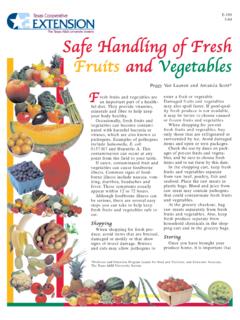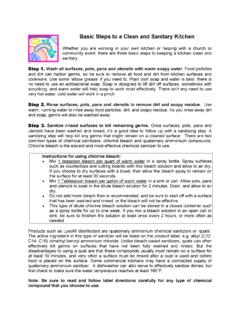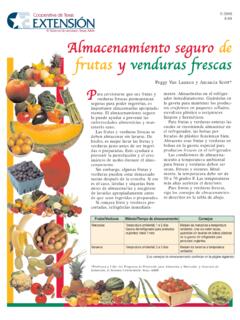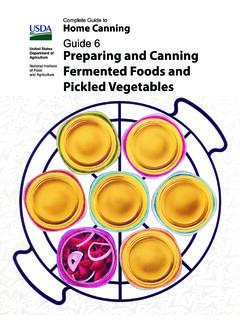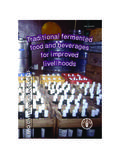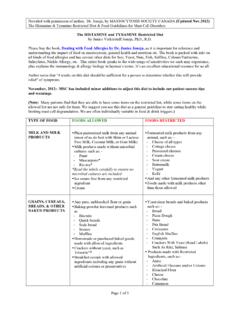Transcription of Guidance for Industry - Food safety
1 Guidance for Industry Acidified Foods Draft Guidance This Guidance document is being distributed for comment purposes only. Although you can comment on any Guidance at any time (see 21 CFR (g)(5)), to ensure that the agency considers your comment on this draft Guidance before it begins work on the final version of the Guidance , submit electronic or written comments on the draft Guidance within 60 days of publication in the Federal Register of the notice announcing the availability of the draft Guidance . Submit electronic comments to Submit written comments to the Division of Dockets Management (HFA-305), food and Drug Administration, 5630 Fishers Lane, rm. 1061, Rockville, MD 20852. All comments should be identified with the docket number listed in the notice of availability that publishes in the Federal Register.
2 For questions regarding this draft document contact the Center for food safety and Applied Nutrition (CFSAN) at 301-436-2411. Department of Health and Human Services food and Drug Administration Center for food safety and Applied Nutrition September 2010 Contains Nonbinding Recommendations Draft Not for Implementation 2 Table of Contents I. Introduction II. Background A. CGMP Requirements for Low-Acid Foods and Acidified Foods B. Emergency Permit Control Requirements for Acidified Foods III. Discussion and Recommendations A. Acid Foods B. Acidified Foods C. Fermented Foods D. Foods That Are Stored, Distributed and Retailed under Refrigeration E. Repacking Acidified Foods F. Reprocessing Acidified Foods G.
3 Equilibrium pH and Finished Equilibrium pH H. Acid food (s) Containing Small Amounts of Low-Acid food (s) Contains Nonbinding Recommendations Draft Not for Implementation I. Fermented food (s) Containing Small Amounts of Low-Acid food (s) J. Processing Acidified Foods K. Quality Control Procedures to Address Spoilage IV. Examples of Books Available for Purchase V. References Appendix 1. Examples of the Application of Tables 2 Through 6 For Evaluating An Acid food Containing Small Amounts of Low-Acid food (s) Contains Nonbinding Recommendations Draft Not for Implementation Guidance for Industry1 Acidified Foods This draft Guidance , when finalized, will represent the food and Drug Administration's (FDA's) current thinking on this topic.
4 It does not create or confer any rights for or on any person and does not operate to bind FDA or the public. You can use an alternative approach if the approach satisfies the requirements of the applicable statutes and regulations. If you want to discuss an alternative approach, contact the FDA staff responsible for implementing this Guidance . If you cannot identify the appropriate FDA staff, call the telephone number listed on the title page of this Guidance . I. Introduction This Guidance is intended for processors of acidified foods, fermented foods2, and acid foods3. It pertains to the current good manufacturing practice (CGMP) requirements in 21 CFR part 114 for acidified foods and to the Specific Requirements and Conditions for Exemption From or Compliance With an Emergency Permit for acidified foods in 21 CFR and is intended to assist commercial food processors in determining whether their food products are subject to these regulations.
5 It also provides FDA s (our) current thinking on several topics related to the processing of, and process filings for, acidified foods and describes a voluntary program for processors of foods that may not be subject to the regulations for acidified foods. Under the voluntary program, processors may submit process filings for these foods to facilitate our determinations regarding the regulatory status of their foods during inspection of a processor s facility and when their foods are offered for import. Taking part in this voluntary program does not automatically subject processors to the acidified food regulations. FDA's Guidance documents, including this Guidance , do not establish legally enforceable responsibilities.
6 Instead, guidances describe the Agency's current thinking on a topic and should be viewed only as recommendations, unless specific regulatory or statutory requirements are 1 This Guidance has been prepared by the Office of food safety in the Center for food safety and Applied Nutrition at the food and Drug Administration. 2 Fermented dairy products, such as yogurt, are a separate category that is not relevant to the fermented foods that are the subject of this document. 3 Low-acid foods are foods, other than alcoholic beverages, with a finished equilibrium pH greater than and a water activity greater than , except that tomatoes and tomato products having a finished equilibrium pH less than are not classed as low-acid foods (21 CFR (n)).
7 Acidified foods are low-acid foods to which acid(s) or acid food (s) are added; they have a water activity greater than and have a finished equilibrium pH of or below (21 CFR (b)). Acid foods are foods that have a natural pH of or below (21 CFR (a)). Fermented foods, as discussed in this Guidance , are low-acid foods subjected to the action of acid-producing microorganisms to reduce the pH of the food to or below. Contains Nonbinding Recommendations Draft Not for Implementation cited. The use of the word should in Agency guidances means that something is suggested or recommended, but not required. II. Background A. CGMP Requirements for Low-Acid Foods and Acidified Foods FDA (we) has established specific CGMP requirements for thermally processed low-acid foods packaged in hermetically sealed containers ( , low-acid canned foods, hereafter referred to as LACF4) (21 CFR part 113) and acidified foods (21 CFR part 114).
8 In the proposed and final rulemakings for LACF (proposed rule, 41 FR 30444, July 23, 1976; final rule, 44 FR 16209, March 16, 1979) and acidified foods (proposed rule, 41 FR 30457, July 23, 1976; final rule, 44 FR 16230, March 16, 1979), we discussed the need for CGMP requirements to control Clostridium botulinum (C. botulinum). C. botulinum is a bacterium commonly found in soil. It can produce a nerve toxin (botulinum toxin) under anaerobic conditions such as those in canned foods. Botulinum toxin can cause botulism, a rare but serious paralytic illness that can be fatal and is considered a medical emergency (Ref. 1). Under stress (such as thermal processing and physicochemical conditions that are not conducive to growth of vegetative cells), C.
9 Botulinum can form spores that are adapted for prolonged survival under adverse conditions (Ref. 2). Thermal processes using temperatures such as 212 F ( , the temperature of boiling water) or even lower ( , 150 F in some circumstances) can destroy the vegetative cells of C. botulinum, but do not destroy the spores of C. botulinum (see 41 FR 30442 at 30442, July 23, 1976). An acidified food can pose a risk of botulism if pH and other critical factors are not carefully controlled during processing to prevent the germination and growth of viable spores of C. botulinum (44 FR 16204 at 16204, March 16, 1979). When critical factors are not carefully controlled, the vegetative cells of some microorganisms of nonhealth significance (such as some spoilage bacteria, yeasts, and molds) can grow in an acid environment and, in so doing, cause the pH of the food to increase (Refs.)
10 3, 4, and 5). In addition, when critical factors are not properly controlled, some spoilage microorganisms (such as Bacillus licheniformis (B. licheniformis)) produce heat-resistant, acid-tolerant spores that can germinate, grow, and cause the pH to increase; thermal processing that is sufficient to destroy vegetative cells of such microorganisms may not be sufficient to destroy their spores (Refs. 3 and 6 through 9).5 However, when the pH 4 Although some hermetically sealed containers ( , pouches and glass bottles) used to package thermally processed low-acid foods generally would not be viewed as cans, the term low-acid canned foods has been used for decades as a shorthand description for thermally processed low-acid foods packaged in hermetically sealed containers, and we continue to use that term (and its abbreviation, LACF) for the purposes of this document.


